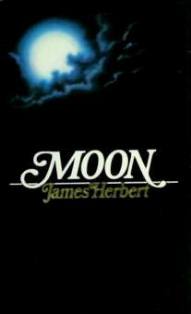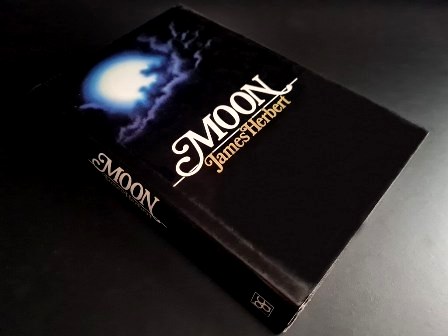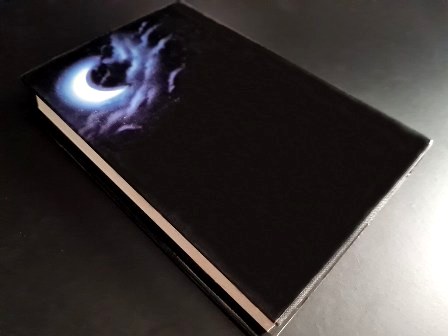
First published back in July of 1985, ‘Moon’ formed the eleventh novel by British horror author James Herbert.
DLS Synopsis:
When Jonathan Childes began to have strange out-of-body-experiences whereby he witnessed the burial of young victims through the eyes of a sadistic child killer, his life unsurprisingly came to a dramatic and devastating head. Although the police were initially, and understandably, very sceptical about his claims, purely as a result of Childes’ visions they eventually managed to track down the child-molesting murderer. However, before they were able to apprehend him, the killer cut his own throat rather than face the inevitable trial and retribution for his ghastly crimes.
However, with the barrage of unwanted publicity that followed, Childes found that he could no longer continue with his marriage, even for the sake of their young daughter Gabriel, and eventually fled to the Channel Islands to start up a new life for himself.
Now, almost three years since his relocation, and thirty-four-year-old Childes was finally feeling reasonably secure in his new life. After giving up a very prosperous career, Childes was now working as a freelance IT teacher for the handful of private schools located on the island. And it’s at the La Roche all-girls school where he had met with twenty-three-year-old French teacher Aimee Sebire, of whom he had slowly begun to build up a close relationship. A relationship that had taken a while to come to fruition solely because of Childes’ ingrained commitment issues.
But then, all of a sudden Childes found that he was again experiencing more of the unnerving and disorientating visions. At first Childes questions exactly what he is seeing. Unclear of the images being presented. Unsure if the visions have any bearing on anything in particular. However, when he witnesses a young boy’s grave being torn open, the small corpse exhumed under the cover of darkness and then cut open, the inner organs removed and the body desecrated – Childes begins to fear for the worse. But it’s only when Childes has a vision of a man, strapped down to a bed, being murdered in a horrifyingly gruesome manner that he picks up the phone and contacts Detective Inspector Ken Overoy.
Because of Overoy’s involvement in the prior case with Childes, the DI had come to accept Childes’ unwanted psychic ability. And so hearing from Childes about these recent visions instantly worries the officer. A fear that is further backed-up by Childes’ knowledge of the grave desecration, with him producing facts that were never released to the public.
However, for Childes the situation is worsening by the day. The visions are becoming more vivid, the crimes they portray of such utter malice and cruelty. Childes cannot accept that whoever is doing these things is in any way human. Such hideous acts of utter brutality are the mark of something inhuman. And he can feel the malignant insanity of the perpetrator seeping into him more and more with the arrival of each vision.
And then he realises that it can now see into his mind too. And all of a sudden it’s at the house of his ex-wife and his young daughter. And his life is comes crashing down on him once again...
DLS Review:
Following the post-apocalyptic splatterpunk-fest that was ‘Domain’ (1984), Herbert’s ‘Moon’ returned to a more supernatural tale of terror akin to that of ‘The Survivor’ (1976) or ‘Shrine’ (1983); although here with a deep-rooted sense of lingering menace creating the predominant platform for much of the tale. Indeed, Herbert has once again shifted his style of writing, adopting something between a supernatural mystery and a serial killer thriller – all with one heck of a bite when it gets the chance.
Okay, so the concept behind the tale isn’t exactly bursting with originality. It’s a bit of a classic horror story idea, maybe not so overused back in 1985 when the novel was first published, but nevertheless, not completely unchartered ground. However, what Herbert brings to the table alongside the principal idea, is a hefty serving of in-your-face brutality of which Herbert has become somewhat of Herbert’s signature trait.
Although the overall plot is relatively straight forward, undoubtedly fleshed-out by a hefty amount of characterisation and sub-plot padding, the reader nevertheless feels like they are following quite an unnecessarily meandering storyline. Furthermore, this reasonably stuttered delivery far from plays to the author’s undoubted strengths at ploughing ever onwards with an enthralling and fast-paced or highly-involved storyline. Instead, with ‘Moon’ we are left simply pondering far too often, without enough horror taking root in the unveiling storyline to really get the reader engaged.
However, when Herbert does get around to unleashing some of his horror magic, then it leaps out from the page with the absolute gusto of a rabid maniac hell-bent on destruction. The build-up to such scenes is negligible, other than a general murmur of a creeping unease rising a little further to the surface. But then, when the grotesque and violent horror comes, it hits the reader with the full force of the author’s not-forgotten splatterpunk days.
Expect harsh and no-holds-barred violence and /or repellent horror and gore when it gets the chance. There’s insanity afoot and what Herbert is going to produce from this fertile ground is drenched in the kind of dark and twisted horror that has been an absolute key to much of his prior work.
So to say that ‘Moon’ is a bit of a mixed bag pretty much hits the nail on the head. It has its moments, but to be honest, these are just a little too few and far between to keep the horror cogs turning at anything close to a constant rate. Instead what we’re left with is a tale that is either dragging or sprinting; its constant fluctuation between peaks and troughs defining a novel that is very much hitting the mediocre status.
But as I said…it still has its moments.
The novel runs for a total of 272 pages.

© DLS Reviews









